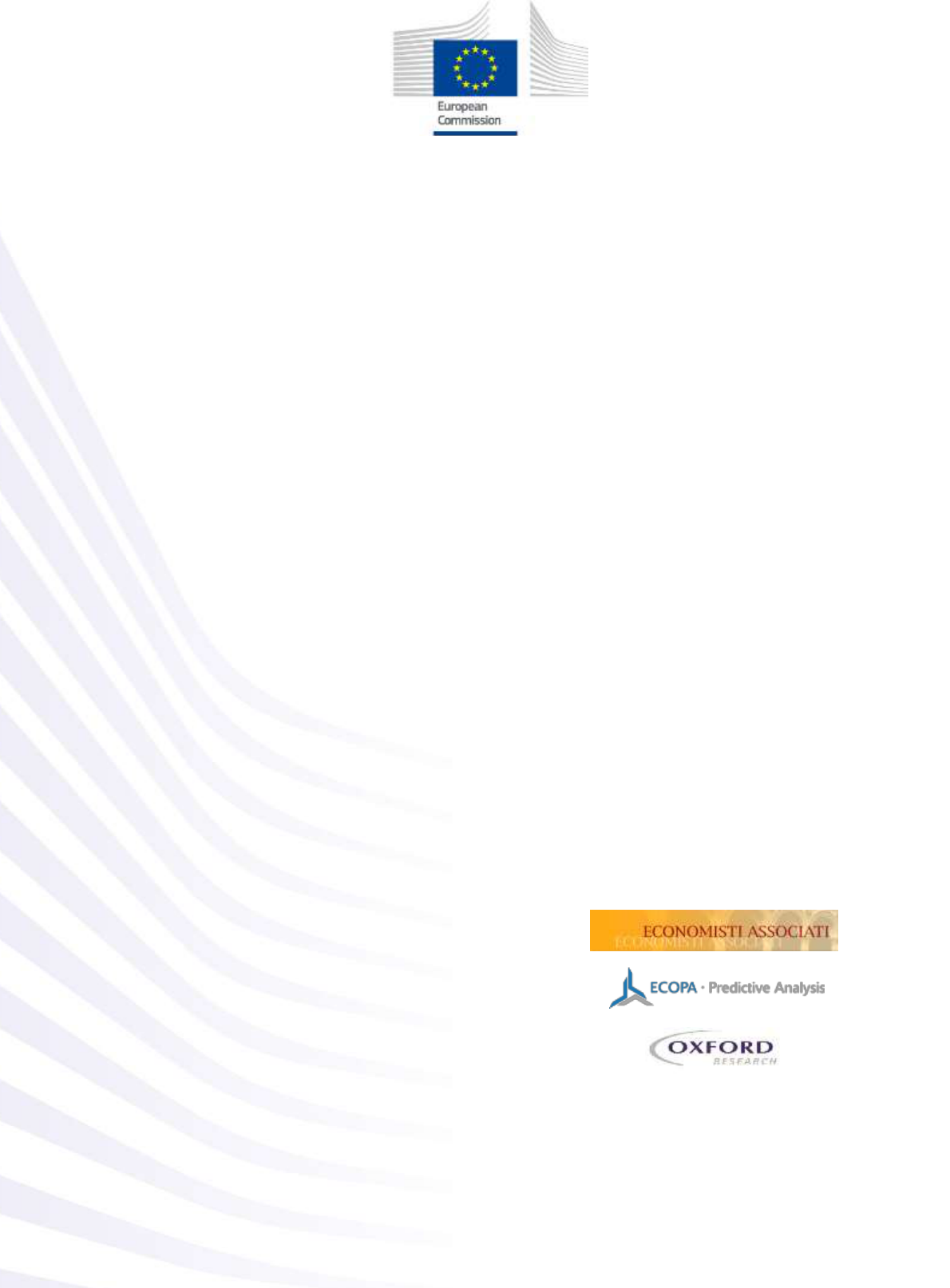
Evaluation of Administrative
Cooperation in Direct Taxation
FINAL REPORT
Executive Summary
24 April 2019

EUROPEAN COMMISSION
Directorate-General Taxation and Customs Union
Directorate D – Direct taxation, Tax coordination, Economic analysis and Evaluation
Unit D.2 – Direct Tax Policy and Cooperation
Contact: Kirsi Haapakoski (Ms)
E-mail: kirsi.ha[email protected]uropa.eu
European Commission
B-1049 Brussels

LEGAL NOTICE
The information and views set out in this report are those of the authors and do not necessarily reflect the official opinion
of the Commission. The Commission does not guarantee the accuracy of the data included in this study. Neither the
Commission nor any person acting on the Commission’s behalf may be held responsible for the use which may be made
of the information contained therein.
More information on the European Union is available on the Internet (http://www.europa.eu).
Luxembourg: Publications Office of the European Union, 2019
ISBN 978-92-76-02917-5
doi: 10.2778/865485
© European Union, 2019
Reproduction is authorised provided the source is acknowledged.
Europe Direct is a service to help you find answers
to your questions about the European Union.
Freephone number (*):
00 800 6 7 8 9 10 11
(*) The information given is free, as are most calls (though some operators, phone
boxes or hotels may charge you).
Abbreviations and Acronyms
ACDT
Administrative Cooperation in Direct Taxation
AEOI
Automatic Exchange of Information
CRS
Common Reporting Standard
DAC
Directive on Administrative Cooperation
DF
Director’s Fees
DG TAXUD
Directorate General for Taxation and Customs Union
EI
Income from Employment
EOI
Exchange of Information
EOIR
Exchange of Information on Request
EU
European Union
EUAV
EU Added Value
FATCA
Foreign Account Tax Compliance Act
GDP
Gross Domestic Product
GNI
Gross National Income
IP
Immovable Property
IT
Information Technology
LIP
Life Insurance Products
OECD
Organization for Economic Co-operation and Development
PAOE
Presence in Administrative Offices and participation in administrative Enquiries
PEN
Pensions
SC
Simultaneous Controls
SEOI
Spontaneous Exchange of Information

Evaluation of Administrative Cooperation in Direct Taxation
1
1 INTRODUCTION
This Evaluation Study was prepared for the European Commission – Directorate General for
Taxation and Customs Union (DG TAXUD) and it is intended to support the forthcoming
Commission Evaluation of the Council Directive 2011/16 on administrative cooperation
in the field of taxation
1
(hereinafter, the ‘Directive on Administrative Cooperation’, or just the
‘Directive’).
The Study purports to provide a comprehensive assessment of the Directive; more
specifically, the Report pursues the two-fold objective of: (i) assessing the implementation and
results, and (ii) developing recommendations for the amendment of existing provisions, should
they prove inadequate.
2 THE APPROACH TO THE EVALUATION
The Assignment consists of two components, an Implementation Assessment and an
Evaluation ‘proper’. The former includes an assessment of the transposition and the
implementation of the Directive and of the uptake of its tools and mechanisms – i.e. the extent
to which they have been used by the Member States. The latter involves an assessment of the
Directive along the five evaluation criteria commonly used for the assessment of the EU
initiatives, namely: (i) relevance, (ii) effectiveness, (iii) efficiency, (iv) coherence, and (v) EU
added value.
The Study is based on the information derived from documentary sources or obtained during the
consultations with relevant stakeholders:
1) The documentary sources consist primarily of various datasets on administrative
cooperation activities, comprising information provided by the Member States to the
Commission as part of the reporting obligations spelled out in the Directive. The datasets
encompass ‘statistics’, which include information on the number and nature of the exchanges
that have occurred via the Directive mechanisms, and ‘questionnaires’, through which
Member States provide qualitative and quantitative information on the working of the
Directive
2) The datasets made available by the Client were complemented with information from the
analysis of other documentary sources, mostly academic studies and documents from
international organisations and national governments.
3) Overall 39 institutions, organisations and economic operators from 15 Member States were
consulted during the two targeted consultations carried out for the Study, one aimed at
national tax authorities, and another for other stakeholders. For the former, seven tax
authorities were consulted in the early phase of the Assignment, and another round of
targeted consultation was organised, covering ten Member States. All in all, 14 tax authorities
participated to the two phases of the targeted consultation. For other stakeholders, the
consultation targeted financial sector organisations and companies, non-governmental
organisations active in tax transparency themes, and tax advisors. In total, 25 private
stakeholders were consulted, including six European organisations and 19 national entities.
4) The Public Consultation carried out by the European Commission, with the Consultants’
support, in order to gather the appreciation of stakeholders and citizens on the working of
the Directive. The consultation was launched on 10 December 2018 and it remained open
until 4 March 2019, for a total of 12 weeks. A total of 30 entities and individuals participated
to the PC, from 10 Member States.
1
Council Directive 2011/16/EU of 15 February 2011 on administrative cooperation in the field of taxation and repealing
Directive 77/799/EEC.

Evaluation of Administrative Cooperation in Direct Taxation
2
3 THE POLICY AT STAKE
Administrative Cooperation in Direct Taxation
In an increasing globalised world, the persistence of significant differences in taxation systems
may negatively affect tax revenue collection, as businesses are able to shift profits across
borders and taxpayers can earn income from abroad without being taxed. This has led to the
development of various cooperation mechanisms among tax authorities, commonly
referred to as ‘Administrative Cooperation In Direct Taxation’ (ACDT).
Access to information on the incomes earned or the assets held abroad via the exchange of
information on taxpayers engaged in cross-border activities is widely regarded as an essential
component of an effective ACDT system. The possible exchanges encompass:
1) the Exchange Of Information on Request (EOIR), which refers to information concerning
specific persons or transactions expressly solicited by the requesting country;
2) the Automatic Exchange Of Information (AEOI), which refers to the exchange of
information in bulk, for all the persons or transactions fulfilling certain criteria, using
predefined formats, secured channels of communication, and at predetermined times; and
3) the Spontaneous Exchange Of Information (SEOI), which refers to the unsystematic,
voluntary furnishing of information that the supplying country may deem to be of interest
for the receiving country.
These exchanges are complemented by other forms of cooperation, including namely the
Presence in Administrative Offices or participation in administrative Enquiries (PAOE),
the carrying out of Simultaneous Controls (SC), and the provision of assistance for the
notification to taxpayers of decisions or instruments regarding their tax liabilities.
The Directive
The Directive on Administrative Cooperation is the fundamental piece of EU legislation on
ACDT, establishing a common approach for the mutual assistance and exchange of information
in the field of direct taxation. The Directive supports the Member States by providing their tax
authorities a legal framework for cooperation, and an Information Technology (IT) environment
and procedures for the safe and secure exchange of information. Its legal basis consists in
Articles 113 and 115 of the Treaty on the Functioning of the European Union (EU). The latter
allows the Council to issue Directives for the approximation of the national legal frameworks
which directly affect the establishment or functioning of the Internal Market, and provides the
basis for the EU to act in the area of cross-border direct taxation. The former allows the Council
to harmonise the legislation concerning, among others, other forms of indirect taxation, which
can include certain levies on capital assets.
The Directive pursues three specific objectives, namely: (i) to improve Member States’ ability to
fight cross-border tax fraud, evasion and avoidance, the latter linked to forms of
aggressive tax planning by multinational enterprises; (ii) to reduce the scope for harmful tax
competition, namely through greater transparency in tax rules; and (iii) to contribute to
enhanced spontaneous tax compliance, through the ‘deterrent effect’ resulting from the
greater ability to detect cross-border incomes and assets.
The major innovation introduced by the original Directive (in short, DAC1) was the introduction
of mandatory AEOI on five categories of incomes and capital (employment income -EI,
pensions -PEN, director’s fees -DF, ownership of and income from immovable property -IP, and
life insurance products -LIP). DAC1 also upgraded the other modalities for enhancing information
exchange among tax authorities, previously regulated by the Mutual Assistance Directive,
2
including EOIR, SEOI, and SC. It also introduces a new tool, that is the possibility for tax officials
to be present in the administrative enquiries carried out by another tax authority (PAOE).
2
Council Directive 77/799/EEC of 19 December 1977 concerning mutual assistance by the competent authorities of the
Member States in the field of direct taxation.

Evaluation of Administrative Cooperation in Direct Taxation
3
The scope of the Directive was progressively expanded through successive amendments,
partly triggered by developments at the international level. A first amendment, adopted in late
2014 (DAC2),
3
extended the scope of mandatory AEOI to financial accounts held by non-
residents on the basis of the Common Reporting Standard (CRS) format. A second amendment,
adopted in late 2015 (DAC3),
4
introduced the mandatory exchange of information on certain
decisions adopted by national tax authorities, namely the cross-border advance tax rulings and
advance pricing agreement. A third amendment, adopted in mid-2016 (DAC4),
5
focused on AEOI
in the area of corporate taxation, and introduced the obligation of Country-by-Country Reporting
for multinational enterprises operating in the EU. Finally, a fourth amendment, adopted in late
2016 (DAC5),
6
was intended to ensure that tax authorities have access to beneficial ownership
information gathered in the context of the anti-money laundering legislation. The
implementation of the Directive is supported by the Fiscalis programme, an EU spending
programme aimed at enhancing cooperation between Member States’ tax authorities in the field
of tax policy.
4 IMPLEMENTATION ASSESSMENT
Transposition and preparation for implementation
The transposition of the Directive was in part late, but substantively unproblematic,
while the intensity of preparatory activities shows major variations across the various
provisions.
The Directive was generally smoothly transposed, and the few issues encountered concerned
the timing of the transposition rather than the alignment of the national frameworks with the
Directive provisions. On average, some 10 Member States were late in transposing the Directive
and each of its amendments, resulting in 57 infringement procedures. However, 54 of these
procedures have been closed, mostly at the very early stages, and only three remain pending;
in no cases were Member States brought before the Court of Justice of the EU.
For all the Directive provisions, the implementation started about as planned and required a
number of preparatory activities at EU and Member States level, in particular for AEOI. The
implementation focused mainly on IT-related aspects, namely the development of the
infrastructure and the formats for the exchange of data. The development has been managed
by DG TAXUD in close collaboration with the Member States and involved planning activities, the
setting-up of the technical and functional specifications, and the testing and rolling of the AEOI
system. Only limited delays in the start of the various AEOI mechanisms were experienced. In
this respect, the timely start of the DAC2 exchanges, despite the occurrence of last-minute
technical issues, appears particularly positive.
Uptake
The Directive triggered the exchange of a substantial amount of information, covering
significant amounts of taxpayers, incomes and assets, with a growing trend
particularly for AEOI.
In 2016, the exchanges under DAC1 AEOI concerned around 7.5 million taxpayer positions and
some € 50 billion of incomes, mostly concentrated in incomes from employment and pensions.
Even though the exchange of information under DAC2 is in its early stage, in the first six months
of operation information around 8.3 million accounts and € 2,865 billion of value (in terms of
3
Council Directive 2014/107/EU of 9 December 2014 amending Directive 2011/16/EU as regards mandatory automatic
exchange of information in the field of taxation.
4
Council Directive (EU) 2015/2376 of 8 December 2015 amending Directive 2011/16/EU as regards mandatory
automatic exchange of information in the field of taxation.
5
Council Directive (EU) 2016/881 of 25 May 2016 amending Directive 2011/16/EU as regards mandatory automatic
exchange of information in the field of taxation.
6
Council Directive (EU) 2016/2258 of 6 December 2016 amending Directive 2011/16/EU as regards access to anti-
money-laundering information by tax authorities.

Evaluation of Administrative Cooperation in Direct Taxation
4
account balances) were communicated by the Member States. DAC3, which also was only
recently implemented, led Member States to upload some 18,000 tax rulings in the Central
Directory between July and December 2017.
With regards to tools and mechanisms other than AEOI, between 2013 and 2017, an average of
9,000 EOIR requests was sent per year. EOIR is used by all EU Member States, the largest
senders of requests being Poland, France, and Germany. SEOI was also extensively used and
the annual volumes varied from 10,000 to 80,000 messages per year between 2013 and 2017;
however, most of these exchanges originated from a single country (the Netherlands). With
respect to the other forms of administrative activities, their utilisation is uneven across the
Member States. Over the period covered by the analysis, 229 PAOEs and 202 SCs were carried
out, involving tax officials from 15 and 22 Member States, respectively.
For the mechanisms for which a diachronic comparison is possible, the uptake is on the rise, as
expected. This is definitely the case for DAC1, with a near doubling of volumes between 2015
and 2016, and an expected further increase in 2017 (based on January-June data). In the case
of DAC2, no comparison over time is possible, but the amounts reported have seemingly grown,
when compared with the figures reported under the Savings Directive
7
. The number of EOIRs
remained roughly stable between 2013 and 2017, but it has significantly increased after the
adoption of the Directive in 2013 and is now about 85% higher than the pre-DAC level. While
the involvement of Member States in SCs has been increasing from 2014 onwards, both in terms
of the number of initiatives and of Member States participating, the involvement in PAOEs and
SEOI follows an oscillating trend, with no clear pattern over time.
5 EVALUATION
Relevance
The Directive was relevant at the time it was adopted, and it still is today, as it tackles
substantial problems by fighting tax evasion, as well as fostering tax compliance by
cross-border operators, increasing transparency of fiscal treatments, and contributing
to the fairness of the tax system and to the proper functioning of the Single Market.
Furthermore, it responds to the needs of Member State authorities and is largely in
line with the EU overarching fiscal policies. Across all these dimensions, the Directive’s
relevance scores well, with the marginal exception of the magnitude of some of the
problems that it intends to tackle, and of the partially changing EU policy priorities
over the last decade.
More in details, the magnitude of the problems addressed appears to be quite large for DAC3
and DAC4, which focus on corporate tax avoidance. Indeed, the estimates of the revenues lost
by the Member States because of this phenomenon reach up to 1.7% of the EU Gross Domestic
Product (GDP). The stakes are also significant with respect to the amount of assets held abroad
that were reported under DAC2. These assets represent nearly 5% of the financial assets held
by EU households and non-financial corporations. In some Member States, especially small- and
mid-sized countries, the share can exceed 20% of these financial assets. On a different note,
the tax base captured by DAC1 AEOI appears more marginal, as it represents a mere 0.3% of
the EU Gross National Income (GNI), without major differences across countries. The
geographical distribution of EI, PEN and IP flows is consistent with migration and investment
patterns, suggesting that DAC1 AEOI is a faithful representation of the underlying economic
reality.
The Directive was well aligned with the needs and priorities of the European Union at its adoption.
DAC measures have been repeatedly mentioned as one of the most important EU tools for
fighting against tax evasion and tax avoidance, foster tax compliance and a fair taxation of all
companies and citizens, and these have been steadily among the top priorities for the
Commission and EU citizens alike. Also through its latest amendments, the Directive remained
7
Council Directive 2003/48/EC on taxation of savings income in the form of interest payments.

Evaluation of Administrative Cooperation in Direct Taxation
5
relevant to EU priorities and needs until today. In the last communications from the EU, an
increasing emphasis has been placed on corporate tax avoidance, on fighting aggressive tax
planning, and increasing tax transparency. The inclusion of DAC3 and DAC4 provisions appears
fully aligned to this evolution.
Finally, the appreciation of the fitness-for-purpose of the Directive and its mechanisms and tools
is also positive. The Directive scores very well in terms of its appropriateness to tax authorities’
needs, both overall and considering specific mechanisms. The tax authorities commented that a
single ‘most useful’ tool is difficult to identify; rather, they tend to underline their positive
assessment of the tools on which they are more experienced. Furthermore, the tax authorities
strongly praise the Directive for providing a comprehensive set of tools and mechanisms for the
exchange of information, from which the tool more fit for the purpose at hand can be selected,
and which complement and reinforce each other. With respect to the other general objectives –
improving the functioning of the Single Market and promoting fairness in taxation – the entire
Directive and all its mechanisms are fit in theory, but in practice those targeted at corporate
entities – DAC2, DAC4 and DAC5 – may progressively emerge as more relevant, given that
corporate tax avoidance represents a higher priority for the EU and a larger scale phenomenon
at present.
Effectiveness
The Directive has contributed to an improved ability to fight tax fraud, evasion, and
avoidance, and the limited evidence available suggests that this has already started
translating into incremental tax assessed. While the recent implementation of several
of the provisions does not allow drawing firm conclusions, positive signals were
recorded also as regards the Directive’s potential in increasing spontaneous
compliance through a deterrent effect. No elements have emerged yet as regards the
effects on the reduction in the scope for harmful tax competition.
Undoubtedly, the Directive improved the ability of the Member States to fight against tax fraud,
evasion, and avoidance, with respect to legal and natural persons operating, gaining incomes,
or holding assets across multiple jurisdictions. This is unanimously acknowledged by the tax
authorities, which appreciate especially the ‘menu of options’ that the Directive has created.
Indeed, the various ACDT provisions have resulted in a toolbox, from which the tax officials can
select the most useful tool for the case at hand or the objective to be pursued. Furthermore, the
instruments supported by the Directive complement, trigger, and reinforce each other. This
assessment is undisputed even considering that the quality and timeliness of certain data
exchanges still present some flaws. At the same time, the national tax authorities are still
learning how to best process and use the AEOI data received. The situation is positively evolving,
as Member States are increasingly making use of the AEOI information and their ability to match
it with national taxpayers’ databases has also grown. However, as of 2017, not all Member States
have started employing these data.
The Directive was also intended to contribute to reduce the scope for harmful tax competition,
in particular via the amendments aiming at making the national tax systems more transparent,
i.e. DAC3 and DAC4. On the latter, the first exchanges had just taken place, and hence no
information on their outcomes is available. On the former, the evidence shows that the
transparency of advanced rulings has increased. At the same time, this has so far not affected
the behaviour of tax authorities in granting advanced tax rulings and pricing agreements, nor
the attitude of firms demanding for these rulings.
In addition, the DAC mechanisms in general, and more specifically the AEOI, providing for the
mass exchange of data about taxpayers at large, are expected to have a deterrent effect on
taxpayers, thus increasing the spontaneous compliance with their tax obligations. On this effect,
the evidence is not conclusive, due to the recent implementation of the AEOI mechanisms, and
in particular of DAC2. However, tax authorities are already trying to take advantage of the
deterrence, thus signalling the potential of AEOI in spurring spontaneous tax compliance. In
particular, a number of actions have been launched by various Member States to invite taxpayers

Evaluation of Administrative Cooperation in Direct Taxation
6
to spontaneously comply when discrepancies are identified between their tax declarations and
the data received via the AEOI. The results have seemingly been positive, although no
quantitative analysis of the outcomes is available yet.
As for its general objectives, the Directive was designed to contribute to safeguard Member
States’ tax revenues. Although the analysis is constrained by the very recent implementation of
several DAC provisions, as well as by the lack of data on benefits, the findings show that both
AEOI and provisions other than AEOI have contributed to achieve this objective. In the six
Member States for which data are available, in 2016 and 2017, DAC1 AEOI generated an
estimated increase in the tax assessed of about € 92 million. The extent to which the additional
tax assessed is going to translate into additional tax collected is unclear, as the exemptions and
deductions applicable under double taxation treaties limit the potential revenues. No information
is available on the additional tax assessed thanks to DAC2, DAC3, and DAC4, due to their recent
implementation. Information on the benefits of activities other than AEOI is also quite limited,
with only a handful of countries providing this information. The total value of benefits for the
period 2014-2017 is in the order of € 532 million, with major differences among Member States.
All in all, the benefits from activities other than AEOI appear much higher than those from AEOI,
possibly also because those activities can be more easily linked to the outcome of an audit or
investigation, and of the longer period covered by the data (four years compared to two for
AEOI).
Very limited findings are available on the achievement of the other two general objectives – that
is increasing tax fairness and promoting the proper functioning of the Single Market, as these
impacts remain more elusive to capture even for informed stakeholders, who, during the
targeted consultations, could hardly comment on these aspects. Notwithstanding the limited
number of replies, from the Public Consultation, it results that the Directive is considered as
having positively contributed to increasing the fairness of the tax systems, so that companies
active cross-border and individuals with incomes from or assets in another Member State are
more likely to pay their fair contribution. In line with this, the Directive’s role in ensuring that
cross-border companies do not enjoy an undue advantage – so that the Single Market functions
more properly – is also praised by the Public Consultation respondents.
Efficiency
The Directive generated compliance costs and administrative burdens for Member
States, economic operators (particularly financial institutions), and taxpayers. Data
are too limited in order to draw firm conclusions on the cost-effectiveness, although
in the medium term the Directive is estimated to generate net benefits.
The compliance costs quantified for 2015-2017 amount to nearly € 145 million. Most of the costs
come from the AEOI mechanisms, whose deployment and operation required about € 130 million
from national budgets, and an additional € 13 million of EU support. The costs were largely
incurred for the development of the IT systems (about 85% of the costs so far). IT compliance
costs for financial operators to comply with the DAC2 provisions are also likely to be significant,
and some independent sources estimate them at ten times the costs borne by the tax authorities,
although a detailed assessment could not be provided. The fulfilment of the Directive’s reporting
obligations by Member States requires about 12 person/days per year in each country, and the
total annual administrative burden at EU level thus amounts to around € 80,000.
In terms of cost savings, as reported by the tax authorities in the targeted consultation, the
Directive has improved the efficiency of the EOIR mechanisms, because of the standardisation
introduced by the e-forms and the common communication network. These IT tools made
preparing, handling, and processing the requests for information faster and easier, compared
with both the pre-Directive environment, and the mechanisms available under other legal
frameworks. However, no quantification of the efficiency gains for tax authorities was possible,
since the time and effort required to prepare and handle an EOIR and retrieve the information
required vary widely on a case-by-case basis, in particular depending on whether a local tax
office needs to be alerted, whether an interaction with the taxpayer is needed, and through

Evaluation of Administrative Cooperation in Direct Taxation
7
which modality. Differently, the burden reduction enjoyed by taxpayers tanks to the pre-filling
of tax declarations made possible by the AEOI could be quantified, and are estimated in the
range of € 0.5-1 million per year.
An assessment of the cost-effectiveness of the Directive is complicated, for four reasons: (i) a
temporal hiatus between costs, incurred up-front, and benefits, which are slowly materialising;
(ii) the lack of sufficient data on additional tax assessed, as they are only available from nine
Member States; (iii) the significant variations in reported additional tax base or assessed, which
may indicate the presence of outliers; and (iv) the impossibility to accurately disentangle the
costs for tax authorities and financial institutions due to DAC2 to those generated by the
implementation of the CRS and Foreign Account Tax Compliance Act (FATCA) framework. Hence
it is not yet possible to provide a definitive judgment on whether the outcomes achieved were
commensurate with the costs incurred at EU level.
With all these caveats in mind, the Study does provide an estimation of whether, in the countries
for which benefit data are available, the net benefits that the Directive has generated so far are
positive or not. In all these Member States, the regulatory costs borne by the public authorities
for implementing the DAC are lower than the additional tax assessed. Even when considering
also the likely costs for financial institutions, benefits can be assessed to have overcome the
costs in most cases. It is thus likely that, over the 2015-2017 period, the Directive has generated
positive net benefits, when measured in terms of additional tax assessed.
Since a large share of the costs due to the AEOI systems have already been borne and
considering that the benefits will grow the more the tax authorities effectively use the data
received, over the medium-to-long term the net benefits can be reasonably expected to grow.
At the same time, given that there is yet no information on the extent to which additional tax
assessed will create additional tax revenues, and given this availability of data on benefits, the
degree of uncertainty of this assessment remains significant.
Coherence
No major issues of coherence have emerged from the assessment, both internal to the
Directive and external with respect to other adjacent pieces of legislation.
The good internal coherence of the Directive is noteworthy, given that it has been subject to
repeated and frequent amendments. None of the various definitions and legal standards is a
recurrent cause of impediments to the exchange of information among tax authorities. The
common understanding of the Directive’s provisions and their smooth implementation is also
eased by the common reliance on the Organization for Economic Co-operation and Development
(OECD) explanatory documents. Some minor drawbacks were identified with respect to the
coherence of the Directive with the administrative cooperation in the field of Value-Added Tax,
8
which becomes particularly evident when the same activity covers both direct and indirect taxes.
No negative interactions were identified with the Recovery Directive.
9
As far as the anti-money
laundering legislation is concerned, the differences in the legal definitions under the two
frameworks could have limited the potential synergies with DAC2 and DAC5, and caused some
overlapping compliance efforts during the early implementation of DAC2/CRS. Finally, although
the OECD framework and the EU legislation are well aligned, the tax authorities indicated some
burdensome discrepancies, e.g. between the DAC3 and Base Erosion and Profit Shifting
framework, between the technical specifications under DAC2 and CRS, and between the
deadlines for EOIR.
8
Council Regulation (EU) No 904/2010 of 7 October 2010 on administrative cooperation and combating fraud in the field
of value added tax.
9
Council Directive 2010/24/EU of 16 March 2010 concerning mutual assistance for the recovery of claims relating to
taxes, duties and other measures.

Evaluation of Administrative Cooperation in Direct Taxation
8
EU Added Value
The EU action in the area of ACDT has generated an added value compared to its
possible alternatives, particularly when DAC1 AEOI and the increased efficiency of
provisions other than AEOI are concerned.
First, the Directive resulted in additional benefits, the EU added Value of which could in part be
quantified. Indeed, the benefits reported for DAC1 derive from an EU intervention which does
not have any counterpart among the international initiatives and would have not been
undertaken by Member States spontaneously. In six Member States for which data are available,
the EU added value of this mechanism amounted to € 92 million of additional tax assessed in
2016 and 2017
Secondly, the Directive has resulted in efficiency gains, concerning DAC1, DAC2, and DAC3
exchanges, which are especially pronounced for DAC1 provisions other than AEOI. With respect
to the latter, the e-forms and common communication network that were introduced to
implement the Directive represents a clear advantage for the EU framework compared to the
other international activities, and these would not have been deployed, had the EU action not
been undertaken.
The additionality of the EU intervention in the area of ACDT is not only due to the Directive, but
also to the EU budget support provided via the Fiscalis programmes, which enhanced the value-
for-money of the expenditures on IT infrastructure and software because of the economies of
scale due to acting at the central level. Secondly, these programmes have also augmented the
capacity of the Member States to participate in SC and PAOE, increasing the instances in which
these tools were deployed.
6 POSSIBLE WAYS FORWARD
There is a limited appetite for further changes to the Directive in the short term, as
none of the revisions discussed with the tax authorities gained a vast support.
During the targeted consultation, the tax authorities were invited to comment on a list of possible
revisions to the Directive, and namely: (i) the mandatory inclusion of the tax identification
number of the residence country in the DAC1 AEOI records; (ii) the removal of the
acknowledgement of receipt for EOIR and SEOI; (iii) the combination of Articles 6 and 11 on
“Administrative enquiries” and “Presence in administrative offices and participation in
administrative enquiries”; (iv) the explicit introduction of “joint audits”; (v) the removal of the
availability clause in DAC1 AEOI (hence making the exchange of data on certain incomes and
assets mandatory); and (vi) the inclusion of new income categories under DAC1 AEOI; (vii) the
need to clarify a number of Directive’s definitions and legal standards, such as the difference
between taxes and fees, the standard of foreseeable relevance, the handling of group requests,
or the possibility to use ACDT information for purposes other than taxation. The tax authorities
and the other stakeholders could also indicate any additional revision that they considered
necessary.
None of these revisions gained vast support among the tax authorities. This is possibly an
unintended effect of the fatigue caused by the repeated amendments introduced since the
adoption of the Directive. Also, as it emerged during the Study, several of the provisions of the
Directive are still relatively under deployed (e.g. PAOE), and their potential remains not fully
exploited. This explains the focus of the authorities on learning and exploiting the mechanisms
currently at their disposal, rather than on modifying them or adding additional ones. The only
revision receiving the support of most of the tax authorities would be the non-mandatory
inclusion of additional income categories in DAC1 AEOI. The Evaluation findings also confirm
that, in the short-term, there are no pressing issues which would require a legislative
intervention.

Evaluation of Administrative Cooperation in Direct Taxation
9
The tax authorities would also avoid re-opening the Directive to clarify its definitions and legal
standards. Although clarifications would be largely welcomed, should better be introduced by
means of non-binding guidelines. More importantly, any revision or clarification needs to be
coordinated with the framework for administrative cooperation in the field of indirect taxes and
the OECD standards.

Getting in touch with the EU
In person
All over the European Union there are hundreds of Europe Direct information centres.
You can find the address of the centre nearest you at: https://europa.eu/european-
union/contact_en
On the phone or by email
Europe Direct is a service that answers your questions about the European Union. You
can contact this service:
– by freephone: 00 800 6 7 8 9 10 11 (certain operators may charge for these calls),
– at the following standard number: +32 22999696 or
– by email via: https://europa.eu/european-union/contact_en
Finding information about the EU
Online
Information about the European Union in all the official languages of the EU is available
on the Europa website at: https://europa.eu/european-union/index_en
EU publications
You can download or order free and priced EU publications at:
https://publications.europa.eu/en/publications. Multiple copies of free publications may
be obtained by contacting Europe Direct or your local information centre (see
https://europa.eu/european-union/contact_en).
EU law and related documents
For access to legal information from the EU, including all EU law since 1952 in all the
official language versions, go to EUR-Lex at: http://eur-lex.europa.eu
Open data from the EU
The EU Open Data Portal (http://data.europa.eu/euodp/en) provides access to datasets
from the EU. Data can be downloaded and reused for free, for both commercial and
non-commercial purposes.

KP
-
02
-
19
-
28
5
-
EN
-
N
